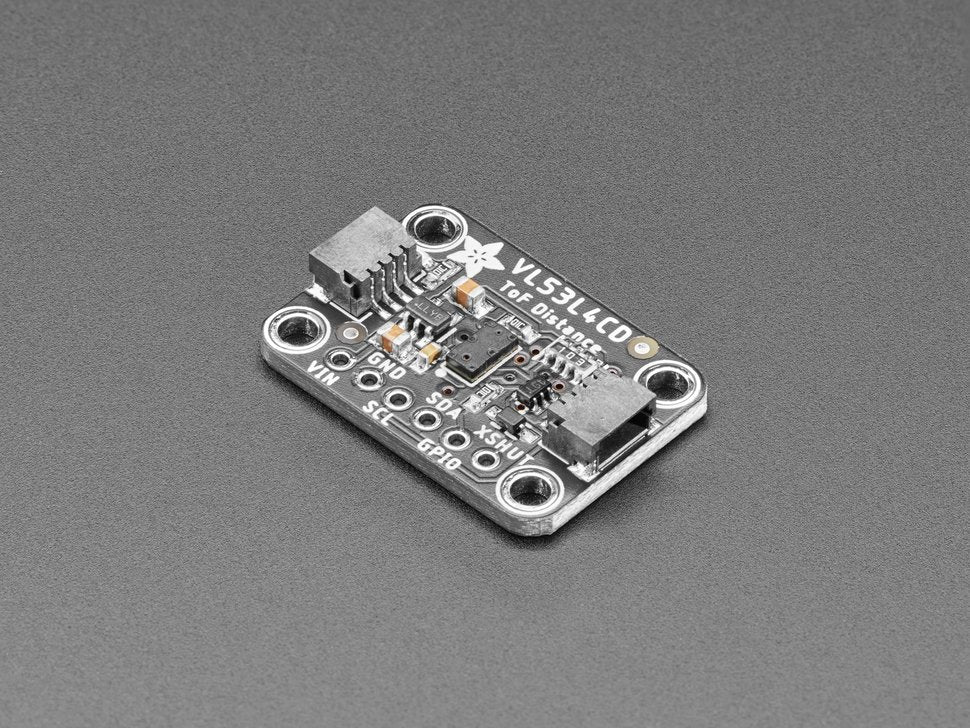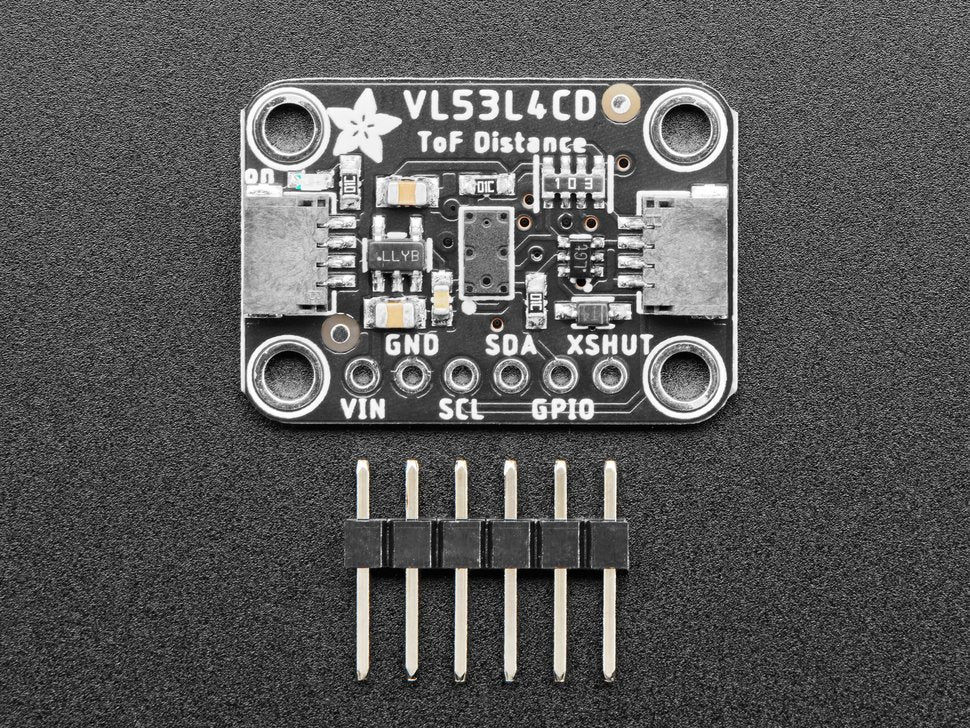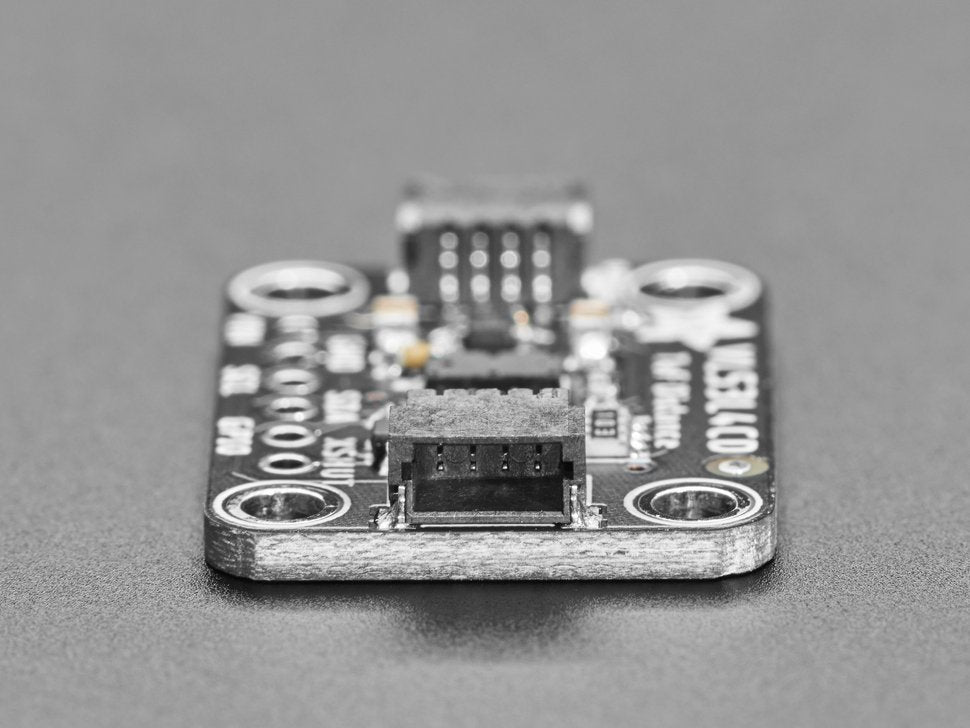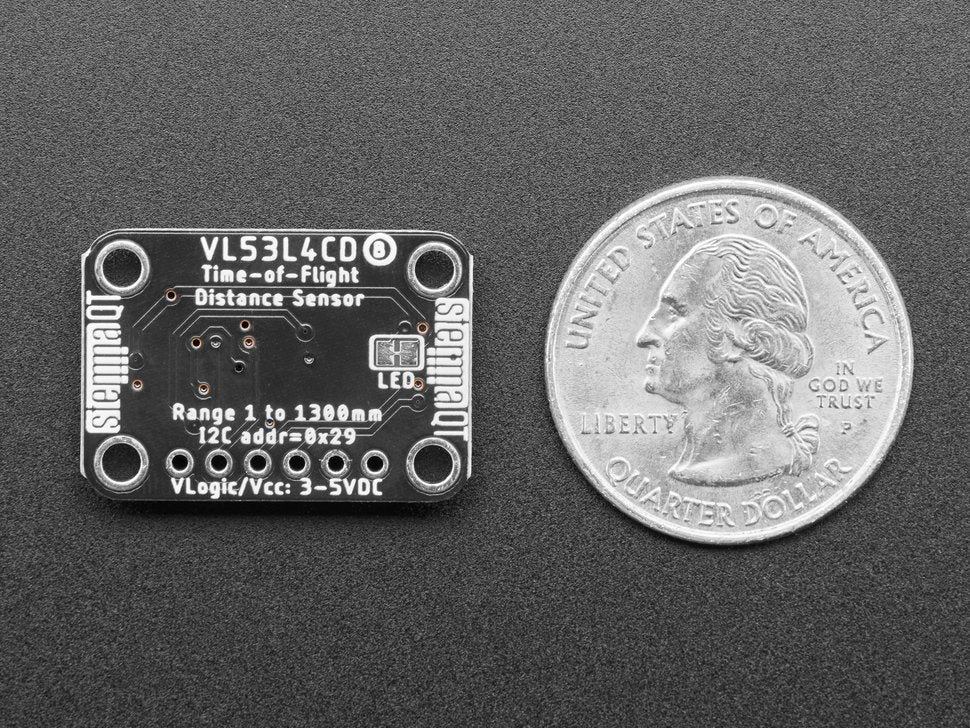Der Adafruit VL53L4CD Time of Flight Sensor ist ein weiterer großartiger Time of Flight-Entfernungssensor von ST aus der VL5-Chipserie, der sich hervorragend für kürzere Entfernungen eignet. Der Sensor enthält eine sehr kleine unsichtbare Laserquelle und einen passenden Sensor. Der VL53L4CD kann die "Flugzeit" ermitteln, d. h. die Zeit, die das Licht benötigt, um zum Sensor zurückzuprallen. Da er eine sehr schmale Lichtquelle verwendet, kann er nur die Entfernung der Oberfläche direkt vor ihm bestimmen. Im Gegensatz zu Sonaren, die Ultraschallwellen reflektieren, ist der "Kegel" des Sensors sehr schmal. Im Gegensatz zu IR-Entfernungssensoren, die versuchen, die Menge des zurückgeworfenen Lichts zu messen, ist der VL53 viel präziser und hat keine Linearitätsprobleme oder "Doppelbilder", bei denen man nicht erkennen kann, ob ein Objekt sehr weit entfernt oder sehr nah ist.
Es handelt sich um eine weitere "große Schwester" des VL6180X ToF-Sensors, die eine Reichweite von ca. 1 bis 1300 mm hat: Im Grunde kombiniert sie die kurze Reichweite des VL6180X, der bis zum Gehäuse des Sensors messen kann, mit der größeren Reichweite des VL53L0X, der eine Reichweite von 50 bis 1200 mm hat.
Der Sensor ist klein und lässt sich leicht in jedem Robotik- oder interaktiven Projekt einsetzen. Da er 2,8 V Spannung und Logik benötigt, hat Adafruit den kleinen Kerl auf ein Breakout-Board mit einem Regler und Level-Shifting gesetzt. Sie können ihn problemlos mit jedem Mikrocontroller mit 3-5 V Spannung oder Logik verwenden. Mit dem 3,3-V-Logikpegel eines Feather oder Raspberry Pi oder dem 5-V-Pegel eines Metro 328 oder Arduino Uno ist dieses Breakout bereit, mit den meisten gängigen Mikrocontrollern oder SBCs zu arbeiten. Und da es I2C kompatibel ist, können Sie es einfach mit zwei Datenleitungen plus Strom und Masse anschließen.
Als ob das noch nicht genug wäre, hat Adafruit auch noch SparkFun qwiic-kompatible STEMMA QT-Stecker für den I2C-Bus hinzugefügt, so dass Sie nicht einmal löten müssen. Schließen Sie einfach Ihren Lieblingsmikrokontroller mit einem Plug-and-Play-Kabel an, um ToF-Daten so schnell wie möglich zu erhalten. Wenn Sie nicht löten möchten, schließen Sie Ihren Lieblingsmikrokontroller wie den STM32F405 Feather einfach mit einem STEMMA QT-Adapterkabel an. Dank der QT-Anschlüsse von Stemma kann der VL53L4CD auch mit Adafruits vielfältigen Zubehör verwendet werden. Das QT-Kabel ist nicht im Lieferumfang enthalten.
Die Kommunikation mit dem Sensor erfolgt über I2C mit einer von ST geschriebenen API. Es gibt eine Arduino-Bibliothek mit einem Beispiel für die Kommunikation hier.
Technische Details
- Leistungsstarker Näherungssensor
- Von 0 bis 1200 mm mit vollem Sichtfeld (FoV)
- Kurzstreckenlinearität bis zu 1 mm
- Diagonale FoV von 18 °
- Autonomer Energiesparmodus mit programmierbarer Interrupt-Schwelle zum Aufwecken des Hosts
- Schnelle Messfrequenz von bis zu 100 Hz
- ST-Dokumentation für den VL53LCD-Sensor
Produkt-Abmessungen: 25.5mm x 17.7mm x 4.6mm / 1.0" x 0.7" x 0.2"
Produktgewicht: 1.8g / 0.1oz
English Description
The Adafruit VL53L4CD Time of Flight Sensor is another great Time of Flight distance sensor from ST in the VL5 series of chips, this one is great for shorter distances. The sensor contains a very tiny invisible laser source and a matching sensor. The VL53L4CD can detect the "time of flight", or how long the light has taken to bounce back to the sensor. Since it uses a very narrow light source, it is good for determining distance of only the surface directly in front of it. Unlike sonars that bounce ultrasonic waves, the 'cone' of sensing is very narrow. Unlike IR distance sensors that try to measure the amount of light bounced, the VL53 is much more precise and doesn't have linearity problems or 'double imaging' where you can't tell if an object is very far or very close.
This is another 'big sister' of the VL6180X ToF sensor and can handle about ~1 to 1300mm of range distance: basically it combines the short range of the VL6180X in that it can sense up to the body of the sensor, with the increased range of the VL53L0X, which can handle about 50mm to 1200mm of range distance.
The sensor is small and easy to use in any robotics or interactive project. Since it needs 2.8V power and logic Adafruit put the little fellow on a breakout board with a regulator and level shifting. You can use it with any 3-5V power or logic microcontroller with no worries. Works great with the 3.3V logic level of a Feather or Raspberry Pi, or the 5v level of a Metro 328 or Arduino Uno, this breakout is ready to work with most common microcontrollers or SBCs. and since it speaks I2C, you can easily connect it up with two data wires plus power and ground.
As if that weren't enough, Adafruit has also added SparkFun qwiic compatible STEMMA QT connectors for the I2C bus so you don't even need to solder. Just wire up to your favorite micro with a plug-and-play cable to get ToF data ASAP. For a no-solder experience, just wire up to your favorite micro, like the STM32F405 Feather using a STEMMA QT adapter cable. The Stemma QT connectors also mean the VL53L4CD can be used with Adafruit's various associated accessories. QT Cable is not included.
Communicating to the sensor is done over I2C with an API written by ST, they have an Arduino library with an example for communication here.
Technical Details
Technical specifications:
- High performance proximity sensor
- From 0 to 1200 mm with full field of view (FoV)
- Short distance linearity down to 1 mm
- Diagonal FoV of 18 °
- Autonomous low power mode with interrupt programmable threshold to wake up the host
- Fast ranging frequency up to 100 Hz
- ST documentation for the VL53LCD sensor
Product Dimensions: 25.5mm x 17.7mm x 4.6mm / 1.0" x 0.7" x 0.2"
Product Weight: 1.8g / 0.1oz
Sicherheitsangaben
- Lesen Sie die Bedienungsanleitung sorgfältig durch, bevor Sie das Produkt verwenden.
- Stellen Sie sicher, dass alle Montage- und Installationsanweisungen des Herstellers sorgfältig befolgt werden.
- Verwenden Sie das Produkt nur für den vorgesehenen Zweck.
- Die unsachgemäße Nutzung dieses Produkts kann zu schweren Verletzungen oder Sachschäden führen.
- Nicht für Kinder unter 10 Jahren geeignet.
- Bei unsachgemäßer Verwendung besteht eine Verletzungsgefahr.
- Dieses Produkt entspricht den geltenden Sicherheitsanforderungen der Europäischen Union.
- Dieses Produkt wurde gemäß der GPSR geprüft, die sicherstellt, dass alle relevanten Sicherheitsanforderungen für Konsumgüter eingehalten werden.
Nachverfolgbarkeitsinformationen
Jedes Produkt verfügt über eines oder mehrere der folgenden Merkmale:
- Ein CE-Kennzeichen, das die Einhaltung der Sicherheits-, Gesundheits- und Umweltschutzanforderungen der Europäischen Union anzeigt.
- Eine eindeutige Serien- oder Chargennummer, um die Nachverfolgbarkeit zu gewährleisten und bei Bedarf Rückrufaktionen zu unterstützen.
- Hersteller- und Importeurangaben für den Kundensupport und Sicherheitsanfragen.
Überwachung und Berichterstattung von Vorfällen
Für den unwahrscheinlichen Fall eines Produktproblems haben wir Verfahren implementiert, um:
- Kundenbeschwerden zeitnah bearbeiten.
- Schwerwiegende Vorfälle über das EU Safety Gate/RAPEX-System melden.
- Mit den Marktüberwachungsbehörden zusammenarbeiten, um die öffentliche Sicherheit zu gewährleisten.
Kontakt:
- Email: support [@] pi3g.com
- Telefon: 0341 / 392 858 40
Dieses Produkt ist vollständig mit allen geltenden EU-Vorschriften konform, um die Sicherheit unserer geschätzten Kunden zu gewährleisten.




